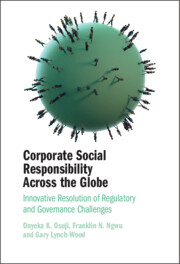 Corporate Social Responsibility Across the Globe
Corporate Social Responsibility Across the Globe from Part III - Stimulating Private Regulation of Corporate Social Responsibility
Published online by Cambridge University Press: 15 June 2023
The chapter argues that socially responsible investment (SRI) can be linked to long-term financial success and therefore should be part of the corporate social responsibility (CSR) strategy of investors. It shows how capital providers, including ordinary shareholders, institutional investors and socially responsible investors, can provide the stimulus for improvements in CSR standards and performance. The chapter traces the origins of SRI and investigates the range of powers and responsibilities, procedures and opportunities that can be applied to encourage a greater degree of participation of different kinds of investor, particularly institutional investors, in SRI.
To save this book to your Kindle, first ensure [email protected] is added to your Approved Personal Document E-mail List under your Personal Document Settings on the Manage Your Content and Devices page of your Amazon account. Then enter the ‘name’ part of your Kindle email address below. Find out more about saving to your Kindle.
Note you can select to save to either the @free.kindle.com or @kindle.com variations. ‘@free.kindle.com’ emails are free but can only be saved to your device when it is connected to wi-fi. ‘@kindle.com’ emails can be delivered even when you are not connected to wi-fi, but note that service fees apply.
Find out more about the Kindle Personal Document Service.
To save content items to your account, please confirm that you agree to abide by our usage policies. If this is the first time you use this feature, you will be asked to authorise Cambridge Core to connect with your account. Find out more about saving content to Dropbox.
To save content items to your account, please confirm that you agree to abide by our usage policies. If this is the first time you use this feature, you will be asked to authorise Cambridge Core to connect with your account. Find out more about saving content to Google Drive.